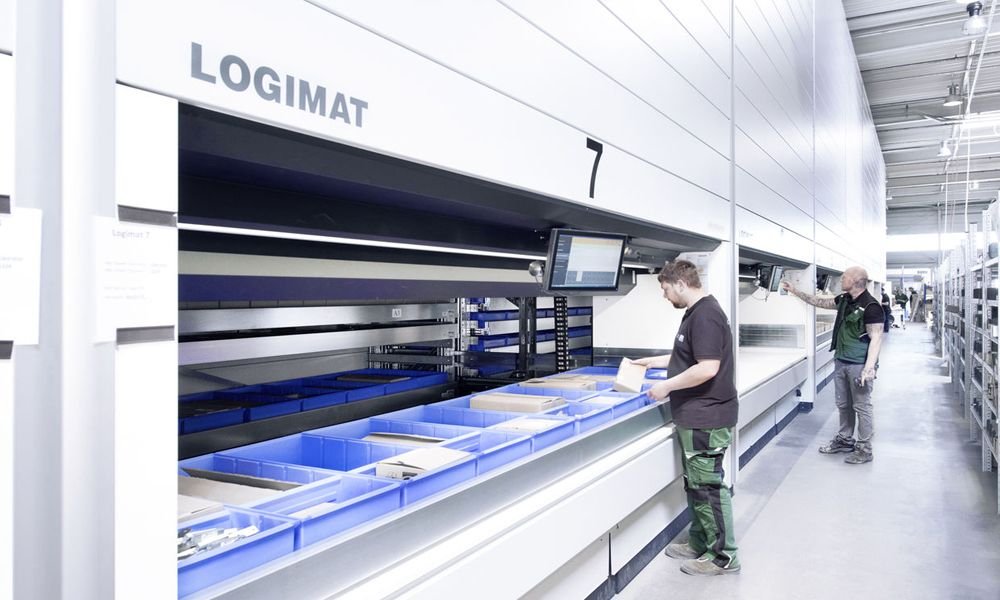PNEUMATI-CON from Flexicon, dilute phase pneumatic conveying systems, range from single-point “up-and-in” installations to cross-plant systems with multiple pick-up and discharge points and automated controls, satisfying an exceptionally wide range of bulk conveying applications. All are custom-engineered and fully integrated with other Flexicon equipment and systems, and new or existing processes.
PNEUMATI-CON dilute phase pneumatic conveying systems move bulk materials that are suspended in an air stream that is introduced by a positive pressure blower upstream of material intake points, or by a vacuum pump that removes air from the system downstream of material discharge points. Material is separated from the conveying air at the use point, then discharged on a batch basis via butterfly or slide gate valves, or continuously via rotary airlock valves.
Easy conveyor line routing
Since conveyor lines can be routed vertically and in any horizontal direction, over short or long distances, through small holes in walls or ceilings, Flexicon PNEUMATI-CON systems are easy to integrate into production environments in which process equipment and other obstacles often exist, while consuming minimal floor space.
Diversity of products handled by one conveyor
Powders having wide ranging bulk densities, as well as flakes, pellets, capsules, tablets and other friable materials, can be handled by a single Flexicon pneumatic conveyor, providing the flexibility needed to transport multiple ingredients.
Total evacuation
PNEUMATI-CON systems fully evacuate the vessel being discharged and the conveyor line itself, minimizing cross-contamination of multi-ingredient systems. Complete transfer of material also ensures that individual and consolidated batch ingredients reach their destinations accurately by weight, maximizing quality while minimizing waste.
Wide capacity range
With a PNEUMATI-CON conveyor, capacity can range from several pounds to tens of tons per hour, feeding any destination from small packaging lines to silos and railcars. Moreover, excessive fluctuations in the feed rate (resulting in overloading or underloading) will not damage the system.
Enclosed system prevents contamination
Totally enclosed and dust-free, a PNEUMATI-CON conveying system prevents contamination of the product and plant environment, allowing safe transfer of contamination-sensitive materials including dusty and hazardous products.
High reliability and ease of maintenance
Flexicon PNEUMATI-CON systems feature easy-to-maintain filter receivers with access doors and inspection ports, as well as rotary airlock valves with optional rotor support bars for easy access, cleaning and inspection.
Mobile and custom configurations
Self-contained Flexicon PNEUMATI-CON conveying systems complete with feed hopper and/or pick-up wand, blower unit, filter receiver and control package, are available pre-engineered and configured on caster-mounted frames for in-plant mobility.
Designed, constructed and finished to industrial and sanitary standards
PNEUMATI-CON conveying systems are available in carbon steel with durable industrial finishes, or stainless steel finished to standards required for industrial, food, dairy and pharmaceutical applications. Available upgrades include quick-access and quick-disconnect fitments.
System Types
Positive pressure systems
Positive pressure dilute phase pneumatic conveying systems are typically employed to convey bulk materials from a single source to one or multiple destinations, over longer distances and with greater capacity than possible using vacuum systems.
These systems utilize a positive displacement blower with single or multiple downstream material entry points, each of which meters product into conveying lines by means of a rotary airlock valve that maintains the pressure differential between the ambient atmosphere and that of the conveying line. Material and air blown through the line exit at single or multiple use points where they are separated by means of a filter receiver or cyclone separator, or fed directly into process vessels that are vented to downstream dust collection devices.
Pressure systems offer higher efficiency than vacuum systems, can convey over longer distances, and can blow directly into process and storage vessels without the use of a rotary airlock valve.
Vacuum systems
Vacuum dilute phase pneumatic conveying systems are generally employed for transporting material from multiple sources such as storage vessels, process equipment, trucks and railcars, to individual or multiple destinations. Unlike positive pressure systems, vacuum systems allow easy pick-up of materials from open containers using wands, and do not impart heat to the material. Since vacuum systems offer superior leak containment, they are often specified on the basis of cleanliness, particularly when handling hazardous materials.
Negative pressure is created by a positive displacement vacuum pump located at the downstream end of the system. Material typically enters the system via upstream rotary airlock valves, hand-held pick-up wands, and non-flow-through/flood-feed pick-up adapters, and exits the system through filter receivers or cyclone separators that separate the material from the conveying air directly above process equipment, inlet hoppers, storage vessels or other discharge points.
In addition, vacuum conveying is suited to direct feeding of blenders, reactors and other enclosed process vessels that are put under vacuum by a line terminating at a downstream bag house or other dust collection device, eliminating the need for individual filter receivers or cyclone separators above each discharge point.
A complete range of pneumatic system components
Flexicon provides any and all components necessary to configure your PNEUMATI-CON system including:
- Flex-tube diverters, wye-diverters, plug diverters and other line diverter configurations
- Rotary airlock valves in all popular designs and sizes
- Filter receivers for low- to high-capacity applications
- Cyclone separators for low- to high-capacity applications
- Gain-in-weight and loss-of-weight batching systems
- Dust collectors and bin vents
- Controls and electrical equipment
- Hand-held pick-up wands
- Silos, day bins and other storage vessels




